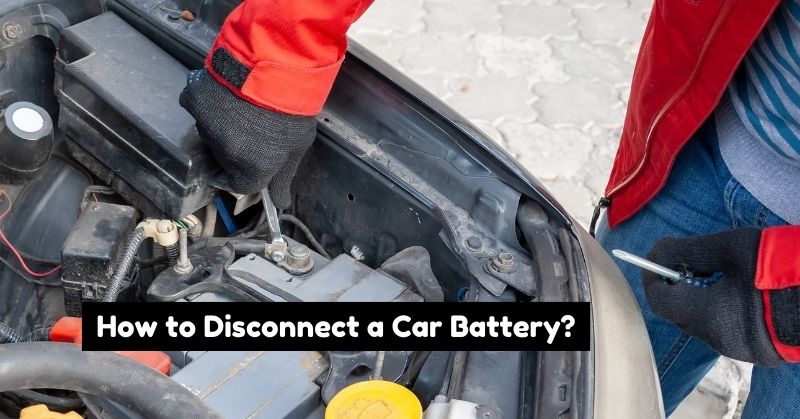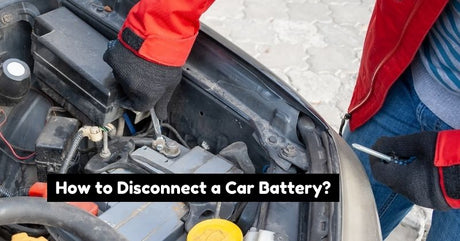Though disconnecting a car battery is simple, and you don't necessarily need to visit a technician for this purpose, not all can perform this task effectively. Whether you want to connect a new battery, perform maintenance, or prevent some damage, you should know how to disconnect a car battery.
If you plan to remove the existing battery from your car for some reason and are looking for a complete step-by-step guide, this article has got you covered. It explains when to remove the battery, what tools you need, and how to disconnect, safety tips, and more. Let's get into detailed specifics.
When do you need to disconnect a car battery?
Among all components of your vehicle, car batteries are the crucial ones. With technological advancements, batteries have started playing more and more prominent roles in modern vehicles.
If we talk about electric vehicles, electric motors and high-voltage batteries have successfully replaced gas engines. Most cars use low-voltage batteries that need premium care. On the other hand, only a professional technician can handle high-voltage car batteries.
It is super simple to disconnect your car battery for various reasons, as listed and discussed below.
- Recharge: If your car battery is completely dead and the alternator can't charge while you drive, you may need to remove the battery and use a suitable charger to help it hold the charge. In case you don't have the right charger, you can visit a nearby technician for efficient charging. If you want to buy a reliable battery charger that best matches your battery requirements, explore the collection available at Renogy.
- Replace: Batteries come with a specific shelf life after which they need replacement. The average lifespan of car batteries is between 3-5 years. If you want to replace the existing battery, you should have the right tools (as listed in the section below) and knowledge to disconnect the battery correctly.
- Store the battery: If you use your car for a few months or for a specific season, it is better to disconnect the battery and store it in a cool, dry place. If you don't remove it from the vehicle, it may lose the charge and become dead at some point.
- Perform maintenance: To avoid electrical issues and danger, you should disconnect the battery while maintaining your vehicle.

What tools do I need to disconnect a car battery?
Certain tools are required to disconnect the battery from your vehicle. Let's look at them.
- Wrench: An adjustable wrench, a socket set, or a wrench set can help you lose the bolts to disconnect the battery cables. Usually, a 10mm open-end wrench does the job efficiently. It is good to have a socket set wrench with a 10mm socket.
- Pliers: You can hold the bolt head with an adjustable plier, whereas a nut plier will help you lose the nuts to disconnect the cables from the battery terminals.
- Hammer: A gentle tap with a hammer can help you lose the battery terminal cable.
- Terminal cleaner: A battery terminal cleaner helps you remove corrosion from the clamps, cables, and terminals.
Other than the ones mentioned above, you may need some other tools while disconnecting your car battery, such as gloves to keep yourself away from hazards, an apron to protect your attire, and goggles to keep your eyes protected.

How to disconnect a car battery?
Now that you know when to disconnect a car battery and what tools you need, it is time to look at the steps required to unhook your vehicle's battery.
1. Turn the car's engine off
First, turn the engine off and remove the key from the ignition switch. If the engine remains on and you try to disconnect a car battery, it may lead to car damage or personal injury. Therefore, keep your personal safety on priority while unhooking the battery.
2. Locate your battery and terminals
Usually, the battery is placed in the engine's compartment in most cars. Some vehicles may have their battery under the rear seat or in the trunk. If you are concerned about the exact location of the battery in your car, don't forget to review the vehicle menu.
As soon as you locate your vehicle's battery, locate its terminals. A positive (+) symbol is printed on the positive terminal and it usually has a red cable. On the other hand, a negative (-) symbol is printed on the negative terminal, which has a black cable.
3. Disconnect the negative terminal
Locating the right terminals is necessary to ensure greater safety. Always disconnect the negative terminal first. It will help you avoid electrical shorts. Lose the bolt with a wrench, carefully remove the cable from the terminal, and keep it aside.
4. Disconnect the positive terminal
Now, remove the cable from the positive battery terminal in the same way as you did for the negative terminal. One thing you must keep in mind is that positive and negative terminals should not touch each other at any point while disconnecting the car battery. You can simply wrap the positive cable's end in any non-conductive material, such as plastic, rubber, or wood.
5. Remove your battery hold-down
A hold-down keeps the battery in place to protect it from vibrations and damage while the vehicle is being driven. Use a wrench to remove the fasteners and then remove the hold-down.
6. Remove your battery
It is time to lift the battery up and take it out of your vehicle. While taking the battery out, don't forget to maintain the level to avoid the acid spilling. Car batteries are heavy, usually around 40 lbs or more. Therefore, lift them up in a way to avoid back injury. Once you remove the battery, place it on a flat and dry surface. This is how to remove a car battery.

Safety tips for avoiding hazards when working with a car battery
Working with your car battery can be hazardous, as chemicals inside the battery can be dangerous to both the car and you. You should care for protective gear, work area, proper battery handling, charging, and maintenance.
When it comes to protective gear, always wear acid-resistant gloves and safety glasses to protect your skin and eyes from corrosive stuff. In addition, remove jewelry and wear rubber boots to ensure your feet' safety.
Make sure the area you are working in is well-ventilated. Always avoid leaning over the battery while testing or charging. To ensure proper handling, follow the manufacturer's guidelines, avoid smoking near the battery, use a plastic brush to clean the terminals, and never work with a battery with bare hands.
Moreover, using an original charger that comes with the battery is recommended. Furthermore, avoid under and overcharging. It helps the battery perform well and last longer. Similarly, don't allow the battery to charge all night or for too long. Using rubber tools on battery cables and electrical tape on maintenance tools help avoid sparks.
Reconnecting your car battery
Do you want to reconnect the battery you removed from the car in the previous section? The steps below will help you get over the line.
1. Clean the battery terminals
Before you begin with reconnecting the car battery, ensure the terminals are clean from dust and corrosion. A mixture of baking soda and water is a perfect solution for removing corrosion from the battery terminals. Dip a toothbrush or wire brush in the solution and gently rub the terminals. Once they are clean, rinse them with clean water and then make them dry.
2. Install your battery
Now, lift the battery while maintaining the level and place it into the tray inside your vehicle. Reinstall the hold-down and use a wrench to tighten the fasteners.
3. Reconnect the battery terminals
Connect the red cable to the positive (+) terminal first and then the black cable to the negative terminal. Use a socket set or adjustable wrench to tighten the fasteners. Make sure there is no loose connection before you proceed.
4. Test the battery
Once the battery is installed and the terminals are connected properly, start your vehicle to see if all components and features are working well, such as horn, headlights, radio, etc. If you find any issue, recheck the battery terminal connections.

Conclusion
Do you have a new battery to install? Don't know how to remove a car battery to install a new one? Well, the process is super simple. All you need to have to have the right set of tools, such as a socket set, wrench set, or adjustable wrench.
While disconnecting the car battery, remove the negative (-) terminal first and then the positive terminals. In contrast, when you reconnect the existing battery or install a new one, connect the positive (+) terminal first and then the negative one. Visit Renogy to buy long-lasting and dependable car batteries at a fair price.









